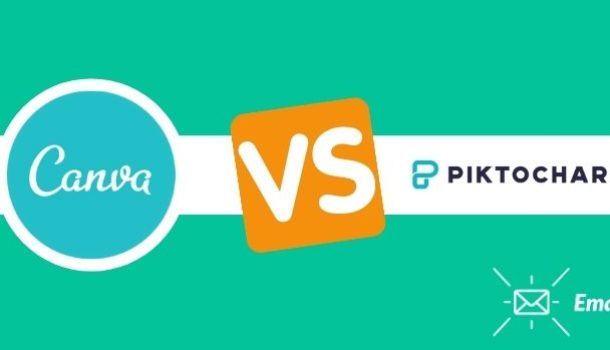What is the best method of keeping visitors on your website other than writing great content?
Well, you guessed it right – it is adding engaging graphics to your site.
Having amazing graphics that people can interact with and learn from can help keep people on your site which will in turn increase the likelihood of them converting into customers.
Canva and Pictochart can help you create amazing infographics, reports as well as professional-looking social media posts that can help people engage with your content in a unique way.
In today’s post I will be comparing the two. By the end of the reading, you will be able to choose the right one for you and your business, so let’s go.
Ease of Use
Canva and Pictochart are by far the easiest graphic design platforms out there.
The number one reason why over 30 million businesses choose to use Canva is because it is easy to use. I recently learned that even professional graphic design opt for it sometimes because it cuts through the corners in what used to be difficult design processes.
Canva gives you a database of over 420 000 readymade templates for you to choose from to start your designs. You can then finish off your designs by dragging and dropping your favorite media components onto your project then click post.
Piktochart is very minimalistic by design so it is very easy to use it. Their interface is very relaxing and welcoming. It would take you just a few minutes to learn how to use it, so it is great for beginners.
Ease of Use Score: Canva: 5/5 Piktochart: 5/5
Both Canva and Pictochart are relatively easy to use no wonder millions of people choose them. The first round between the two is a tie.
Platform
Canva is a platform that was made for non-designers to dip their feet into the world of creating amazing visual content. It has allowed ordinary people to create professional-looking designs with little to no prior training. Canva is jam packed with everything you could dream of as a designer. Many of its users love it because it cuts the time needed to create designs by 10 to 90%.
Piktochart on the other hand was made primarily to help you create infographics. These days you can design posters, presentations and reports. They have a total of just nine templates to choose from, which to me is quite low. You are going to be very limited in your designs.
Platform Score: Canva: 4/5 Piktochart: 2/5
Canva does a great job in serving you with a variety of different design tools and features whilst Piktochart limits your creativity by giving you a tenth of what Canva offers. Canva takes this round.
Performance
Both Canva and Pictochart are cloud-based apps meaning that you will have to have a stable internet connection to use them.
Canva has loads of different features which can lag a bit depending on the computer you use as well as your internet speed.
One negative thing I saw whilst working on Canva was that when I upload and tried to edit any type of media, there was a bit of lag that you encounter.
What I like about Piktochart is that it’s very straightforward and focused.They offer only a few features which is why they rarely experience glitch or lag.
Performance Score: Canva: 4/5 Piktochart: 5/5
Piktochart takes this round because their platform is almost lag free.
Design Tools and Features
Canva has so many design features and tools that if I could try to mention all of them you will run away from my site. Let me try and give you the main ones.
- Photo and video editing capabilities
- Over 75 million media components (videos, stock photos, fonts, design elements, icons, grids, audio, etc.)
- Team collaborations
- One-click background removal
- Creation of Animations GIFs
- Text effects and outlines
- Creating of shadows
- Downloading of transparent backgrounds
- Dedicated support, etc.
Pictochart on the other hand offers you:
- Nine design templates
- Infographic creation capabilities
- Report creation capabilities
- And presentation creation capabilities.
Design Tools and Features Score: Canva: 4/5 Piktochart: 2/5
Canva offers almost any graphic design component you can think of. They easily take this round.
Photo Editing Capabilities
Canva has very basic photo editing capabilities. With them you can resize images, crop them, cut them, and add speech bubbles to them, etc.
Piktochart is an Infographic creation site. It does not have a photo editor to help you with your photo customizations. It specializes in infographics and charts as the name insists.
Photo Editing Capabilities Score: Canva: 3/5 Piktochart: 0/5
Canva takes this round even though they have a very basic photo editor.
Video Editing Capabilities
Both Canva and Pictochart are not well known for their video editing capabilities, more so Piktochart.
Canva has a very basic video editor that allows you to add stock images audio to scenes. You can create amazing slideshows and presentations with it. Their video editor only supports MP4, AVI, WMV, and MKV file formats.
Piktochart again lacks the above functionality, it has no video editing capability. Like we said before, it was made solely for designing infographics and charts.
Video Editing Capabilities Score: Canva: 2/5 Piktochart: 0/5
Piktocharts leaves me no choice but to give it a big zero again. Canva steals this round with a low score of just 2/5.
Integrations & Plugins
Canva integrates with so many cool apps like:
- ColorMix
- Slice
- And Pixabay, etc.
Canva also offers a WordPress plugin that allows you to connect your site with Canva.
Piktochart on the hand integrates with huge sites like Pinterest and Tumblr.
Integrations and Plugins Score: Canva: 3/5 Pictochart: 1/5
Canva takes this round because it has more integrations than Piktochart.
Price
The price for using these two varies a bit. The pricing plan for Canva goes like this:
- The Canva Free Plan is completely free
- The Canva Pro Plan stands at $9.95 per month when billed annually
- The Canva Enterprise Plan stands at $30 monthly when billed annually
When we check out the Piktochart’s pricing plan, you will find out that they offer:
- A freemium plan like Canva.
- A Pro Plan that starts at $29 per month or $290 when billed annually.
- A Team Plan that stands at $99 monthly or $990 when billed annually.
Pricing Score: Canva: 4/5 Pictochart: 1/5
Canva takes the final round to wind up a one-sided encounter.
The overall score stands at: Canva: 27 PicMonkey: 16
This means that our champion for today’s comparison is Canva.
Conclusion
When to choose Canva: Choose Canva if you are looking for the easiest graphic design tool to use in the market.
When to choose Pictochart: Choose Pictochart if you want to create wonderful infographics or create great presentations.
It’s now your turn; which of the two platforms do you favor most? Leave a comment below.

